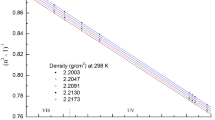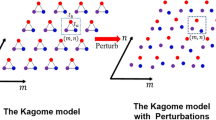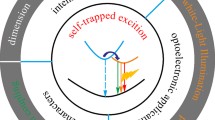Abstract
This work proposes a double quantum dot (DQD) system, with a wetting layer (WL) is included, to study the negative refractive index (NRI) under the application of the electric fields: pump, probe, and fields between WL-QD state, in addition to the magnetic field. The density matrix theory is used to write the equation of motion and an orthogonalized plane wave is used between WL-QD states. The results show that the DQD system exhibit NRI ordinarily until with pump and probe signals, only, due to the manipulation between states. A high NRI corresponding to neglected absorption is obtained under applied electric fields between QD-QD, the conduction (CB) and valence bands (VB) WL-QD fields. It is shown that the main requirement in increasing NRI is the high electric gain connected with a low magnetic one. This can be obtained under five applied electric fields in addition to a high VB WL-QD electric field. Neglecting WL reduces NRI by ~ 16 times. In single QD, the NRI is very small compared with DQD.











Similar content being viewed by others
References
Abdullah, M., Noori, F.T.M., Al-Khurasan, A.H.: Terahertz emission in ladder plus Y-configurations in double quantum dot structure. Appl Opt 16, 5186–5192 (2015)
Al-Ameri, H.H., Abdullah, M., Al-Khursan, A.H.: Entanglement in ladder-plus-Y-double quantum dot structure via entropy. Appl Opt 58, 369–382 (2019)
Al-Husseini, H., Al-Khursan, A.H., Al-Dabagh, S.Y.: III-N QD Lasers. Open Nanosci J 3, 1–11 (2009)
Al-Khursan, A.H., Al-Khakani, M.K., Al-Mossawi, K.H.: Third-order non-linear susceptibility in a three-level QD system. Photonics Nanostructures Fundam Appl 7, 153–160 (2009)
Al-Khursan, A.H., Ghalib, B.A., Al-Obaidi, S.J.: A numerical simulation of optical feedback on a quantum dot lasers. Semiconductors 46, 224–230 (2012)
Al-Nashy, B., Abdullah, M., Al-Shatravi, A.G., Al-Khursan, A.H.: Lasing without population inversion in the four-level Y-type configuration in double quantum dot system. Pramana J Phys 91, 74 (2018)
Al-Nashy, B., Amin, S.M.M., Al-Khursan, A.H.: Kerr effect in Y- configuration double quantum dot system. J. Opt. Soc. Am. B 31, 1991–1996 (2014)
Al-Salihi, F.R., Al-Khursan, A.H.: Electromagnetically induced grating in double quantum dot system. Opt Quantum Electron 52, 185 (2020)
Asada, M., Atsushi, K., Suematsu, Y.: Gain and intervalence band absorption in quantum-well lasers. IEEE J. Quantum Electron 7, 745–753 (1984)
Asadpour, S.H., Sahrai, M., Sadighi-Bonabi, R., Soltani, A., Mahrami, H.: Enhancement of Kerr nonlinearity at long wavelength in a quantum dot nanostructure. Phys E 43, 1759–1762 (2011)
Berman, P.R.: Goos-Hänchen shift in negatively refractive media". Phys. Rev. A 6, 067603 (2002)
Ben-Ezra, Y., Lembrikov, B.I., Haridim, M.: Acceleration of gain recovery and dynamics of electrons in QD-SOA. IEEE J. Quantum Electron 41, 1268–1273 (2005)
Borges, H.S., Sanz, L., Villas-Boas, J.M., Neto, O.D., Alcalde, A.M.: Tunneling induced transparency and slow light in quantum dot molecules. Phys. Rev. B 85, 115425 (2012)
Chuang, S.L.: Physics of photonic devices, 2nd edn. Wiley, New Jersy (2009)
Dolling, G., Wegener, M., Soukoulis, C.M., Linden, S.: Negative-index metamaterial at 780 nm wavelength. Opt. Lett. 1, 53–55 (2007)
Drachev, V.P., Cai, W., Chettiar, U., Yuan, H.K., Sarychev, A.K., Kildishev, A.V., Shalaev, V.M.: Experimental verification of an optical negative-index material". Laser Phys. Lett. 1, 49–55 (2006)
Fang, A.P., Ge, W., Wang, M., Li, F.L., Zubairy, M.S.: Negative refraction without absorption via quantum coherence. Phys. Rev. A 2, 023822 (2016)
Foteinopoulou, S., Economou, E.N., Soukoulis, C.M.: Refraction in media with a negative refractive index. Phys. Rev. Lett. 90, 107402 (2003)
Gorman, J., Hasko, D.G., Williams, D.A.: Charge-qubit operation of an isolated double quantum dot. Phys. Rev. Lett. 95, 090502 (2005)
Hao, X., Wu, J., Wang, Y.: Steady-state absorption–dispersion properties and four wave mixing process in a quantum dot nanostructure. J. Opt. Soc. Am. B 29, 420–428 (2012)
Kastel, J., Fleischhauer, M., Yelin, S.F., Walsworth, R.L.: Tunable negative refraction without absorption via electromagnetically induced chirality. Phys. Rev. Lett. 99, 073602 (2007)
Kim, J., Chuang, S.L.: Theoretical and experimental study of optical gain, refractive index change, and linewidth enhancement factor of p-doped quantum-dot lasers. IEEE J. Quantum Electron 9, 942–952 (2006)
Kim, J., Laemmlin, M., Meuer, C., Bimberg, D., Eisenstein, G.: Static gain saturation model of quantum-dot semiconductor optical amplifiers. IEEE J. Quantum Electron 44, 658–666 (2008)
Lukin, M.D., Yelin, S.F., Fleischhauer, M., Scully, M.O.: Quantum interference effects induced by interacting dark resonances. Phys Rev. A 4, 3225 (1999)
Mahmoudi, M., Sahrai, M.: Absorption-free superluminal light propagation in a quantum-dot molecule. Phys E 41, 1772–1778 (2009)
Miladic, S., Stipsic, P., Dobardzic, E., Milivojevi, M.: Electrical control of a spin qubit in InSb nanowire quantum dots: Strongly suppressed spin relaxation in high magnetic field. Phys. Rev. B 101, 155307 (2020)
Niu, Y., Li, R., Gong, S.: High-efficiency four-wave mixing induced by double-dark resonances in a five-level tripod system. Phys. Rev. A 71, 043819 (2005)
Padilla, W.J., Smith, D.R., Basov, D.N.: Spectroscopy of metamaterials from infrared to optical frequencies. JOSA B 23, 404–414 (2006)
Pendry, J.B.: Negative refraction makes a perfect lens. Phys. Rev. Lett. 18, 3966 (2000)
Rehman, E., Al-Khursan, A.H.: All-optical processes in double quantum dot structure. Appl Opt 55, 7337–7344 (2016)
Sahrai, M., Mehmannavaz, M.R., Sattari, H.: Optically controllable switch for light propagation based on triple coupled quantum dots. Appl Opt 53, 2375–2383 (2014)
Shelby, R.A., Smith, D.R., Schultz, S.: Experimental verification of a negative index of refraction. Science 5514, 77–79 (2001)
Smith, D.R., Smith, D.R., Padilla, W.J., Vier, D.C., Nemat-Nasser, S.C., Schultz, S.: Composite medium with simultaneously negative permeability and permittivity. Phys. Rev. Lett. 18, 4184 (2000)
Stavrou, V.N.: Spin qubits: spin relaxation in coupled quantum dots. J. Phys. Condens. Matter 30, 455301 (2018)
Tarasov, G.G., Zhuchenko, Y.Z., Lisitsa, M.P., Mazur, Y.I., Wang, Z.M., Salamo, G.J., Warming, T., Bimberg, D., Kissel, H.: Optical detection of asymmetric quantum-dot molecules in double-layer InAs/GaAs structures. Semiconductors 40, 79–83 (2006)
Verhagen, E., Waele, R., Kuipers, L., Polman, A.: Three-dimensional negative index of refraction at optical frequencies by coupling plasmonic waveguides. Phys. Rev. Lett. 105, 223901 (2010)
Veselago, V.G.: The electrodynamics of substances with simultaneously negative values of ε and μ. Phys-Uspekhi 10, 509–514 (1968)
Veselago, V., Braginsky, L., Shklover, V., Hafner, C.: Negative refractive index materials. J. Comput Theor Nanosci 2, 189–218 (2006)
Veselago, V.G., Narimanov, E.E.: The left hand of brightness: past, present and future of negative index materials. Nat. Mater. 10, 759–762 (2006)
Villas-Bôas, J.M., Govorov, A.O., Ulloa, S.E.: Coherent control of tunneling in a quantum dot molecule. Phys. Rev. B 69, 125342 (2004)
Wang, H., Zhu, K.: Voltage-controlled negative refractive index in vertically coupled quantum dot systems. Optics Communications 283, 4008–4011 (2010)
Wang, L., Guo, G., Wei, D., Cao, G., Tu, T., Xiao, M., Guo, G.: Gates controlled parallel-coupled double quantum dot on both single layer and bilayer graphene. Appl. Phys. Lett. 99, 112117 (2011)
Zhao, S.C., Qian, X.F., Zhang, Y.P., Zhang, Y.A.: Negative refraction with little loss manipulated by the voltage and pulsed laser in double quantum dots. Prog Theor. Phys. 2, 243–250 (2012)
Author information
Authors and Affiliations
Corresponding author
Ethics declarations
Conflict of interest
The authors declare that they have no conflict of interest.
Additional information
Publisher's Note
Springer Nature remains neutral with regard to jurisdictional claims in published maps and institutional affiliations.
Appendix
Appendix
The dynamical equations of the DQD system shown in Fig. 1 are written as,
Rights and permissions
About this article
Cite this article
Al-Toki, H.G., Al-Khursan, A.H. Negative refraction in the double quantum dot system. Opt Quant Electron 52, 467 (2020). https://doi.org/10.1007/s11082-020-02580-6
Received:
Accepted:
Published:
DOI: https://doi.org/10.1007/s11082-020-02580-6




